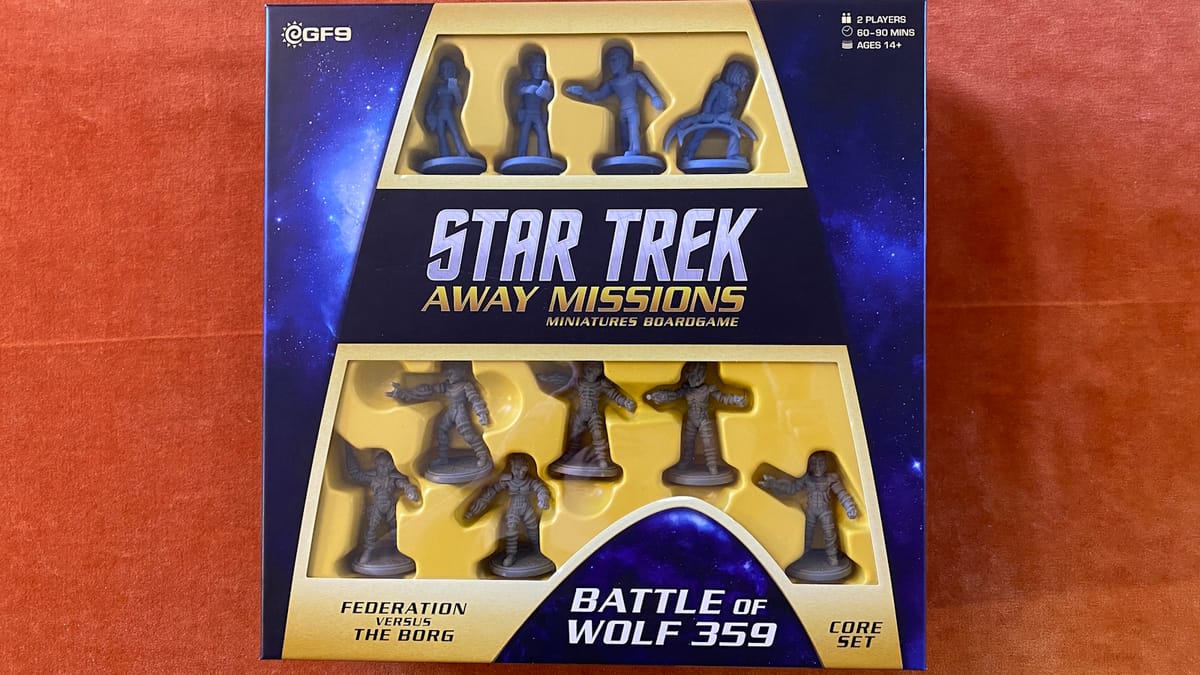
Star Trek: Away Missions is a two player competitive, expandable tactical skirmish game set in the Next Generation universe. The core game has the Federation facing off against the Borg. Unlike most skirmish games, combat isn’t necessarily required. This is both interesting and a potential problem.
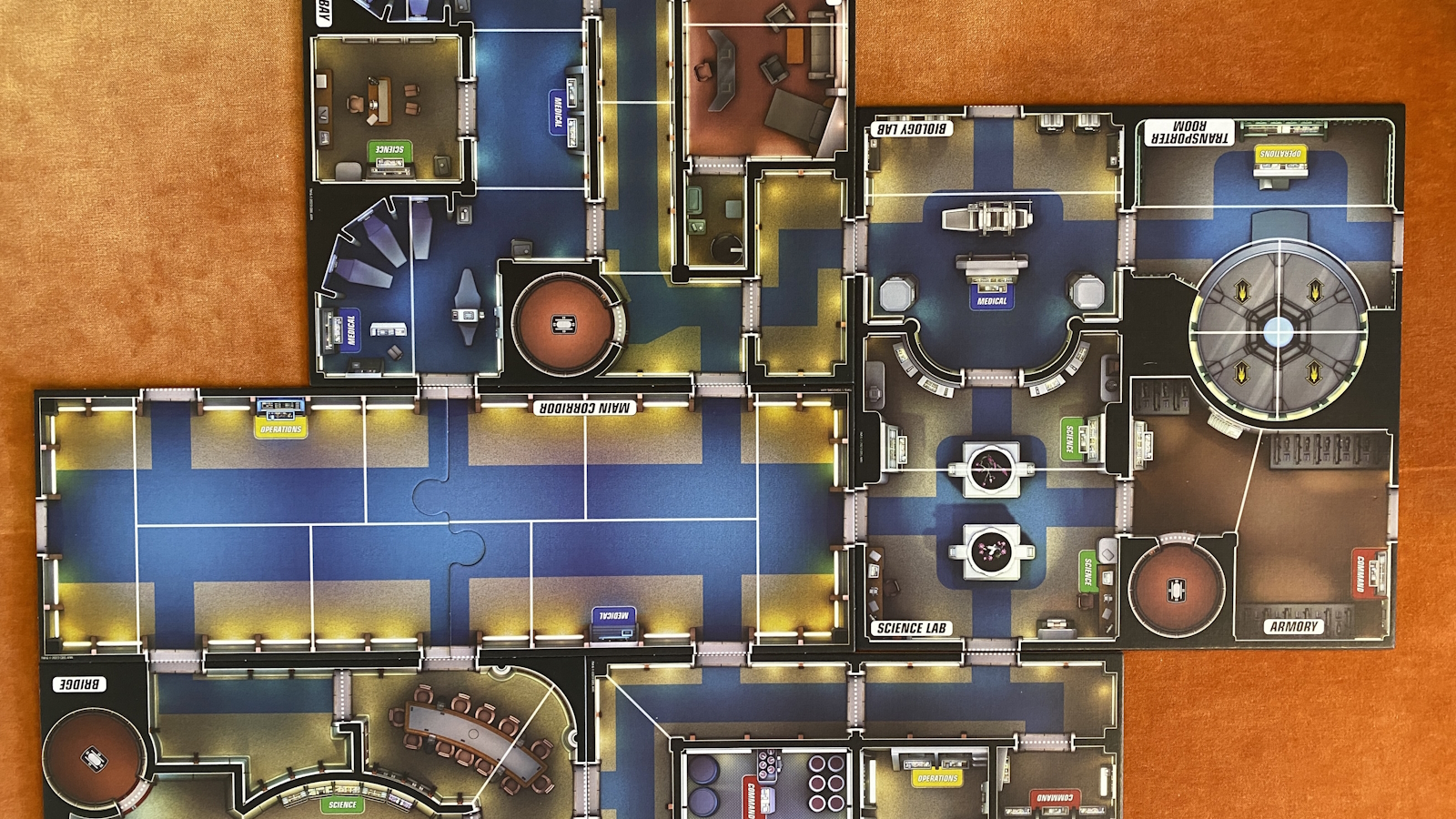
This derelict star ship will soon be under fierce competition.
Components
All of the components are made of good quality materials. The cardboard character boards and tokens, along with the cards, are all thick and durable. The texture on the cards do make them somewhat difficult to shuffle though. The color design of the cards ranges from confusing to atrocious. I constantly have to look at the back of the cards to tell which discard pile they should go in. The color combinations used on the Klingon cards (expansion) are particularly unpleasant. The plastic models are solid and have good details. The dice are good quality and colorful too, but a little on the small side.
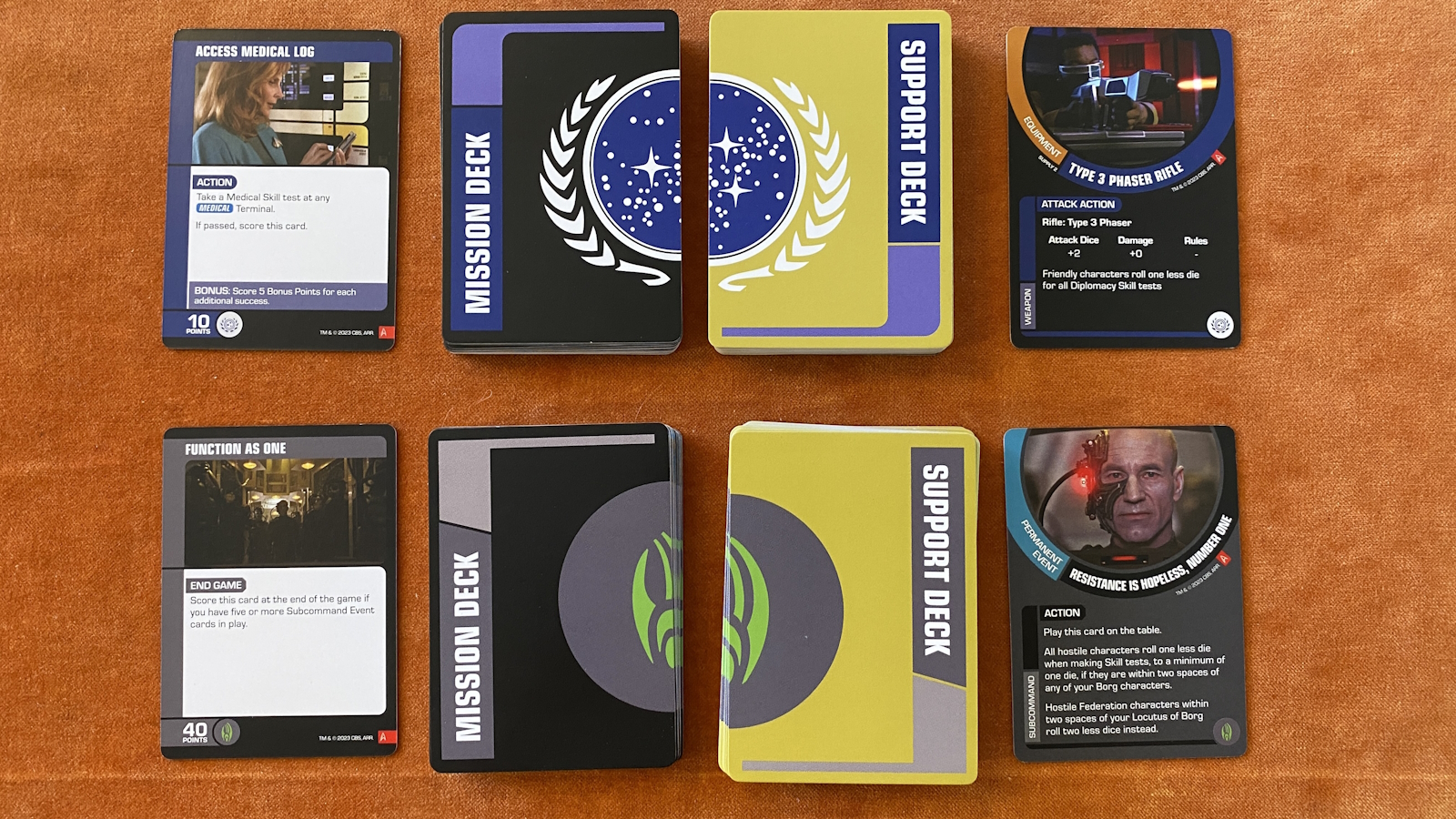
Each away team has two decks of cards. Missions score points, while support cards provide weapons and other abilities.
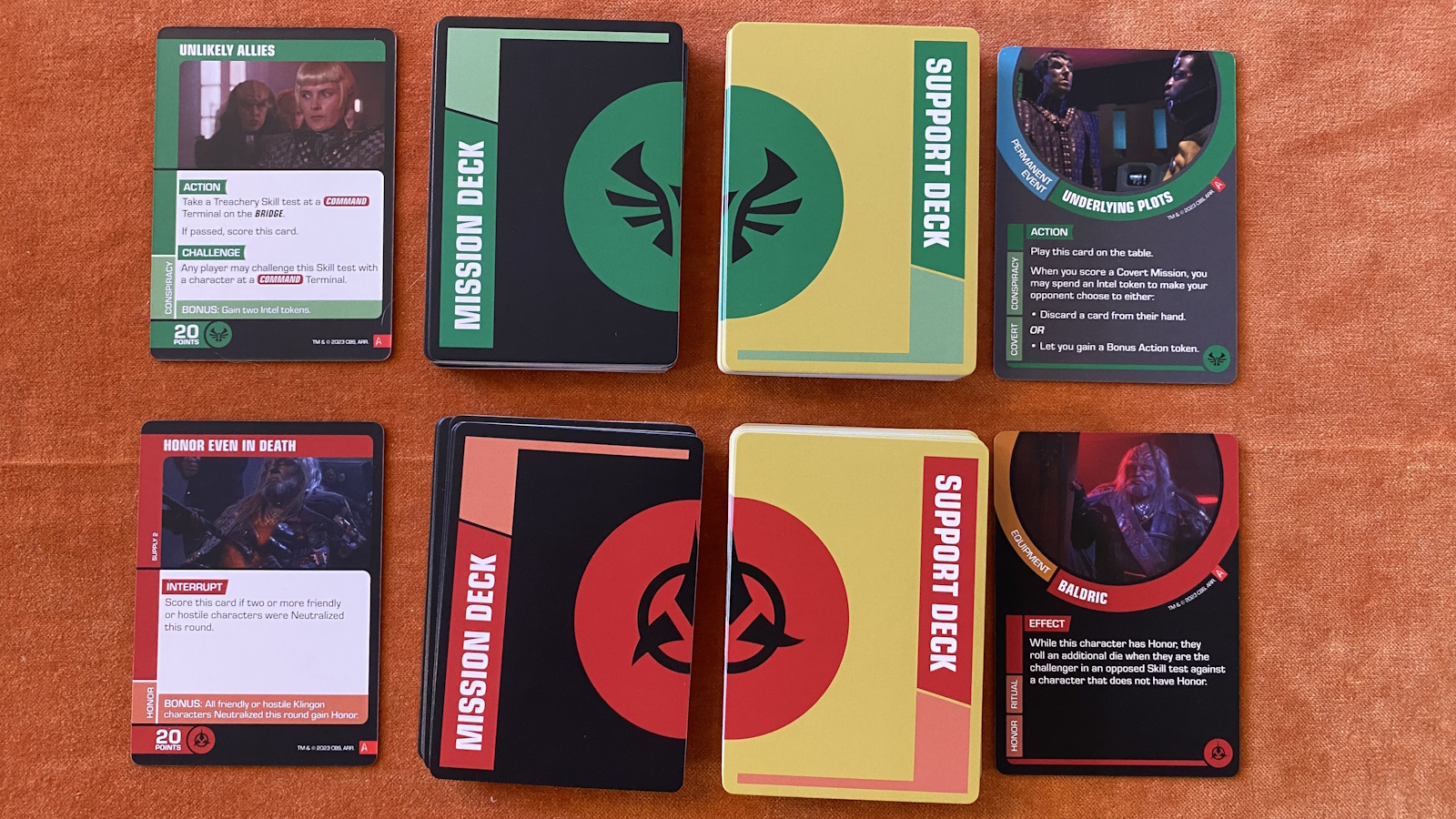
Cards feature stills from the TV show.
The art used in the rulebook and on the cards is all photographs taken from the TV show. The models, however, are a sort of big head cartoon style, which doesn’t match up with anything else in the game. The models are shown on the character boards to help identify which is which character. However, it is often still difficult to tell what character a model is at a glance. They do have names on the base of the model, which while a little difficult to read is what I often use. Sometimes I try using the pose of the model, but this can also be very difficult. The Borg, for example, have five characters named One, Two, Three, Four, and Five, all in very similar poses and looking roughly the same.

Some models look very similar. Luckily, they have their names on the base.
The rulebook is simply alright. The game isn’t too complicated, so I was able to learn it just from reading the rules. There is also a glossary at the back which is nice, but some things aren’t in there and are instead scattered throughout the rulebook. Additionally, there is a quick start booklet, but the intro game is only minorly different and still requires you to reference the full rules, so what is the point?
The statistic tokens, while a cool design, don’t function well. They are good looking plastic stars that match the skill icon printed on the character board. You start the game by placing a star into each slot and then removing them as you take damage. If they had fit snugly and stayed in place, it would have been cool. Instead they are very loose and easily fall out if you nudge the character board during play.
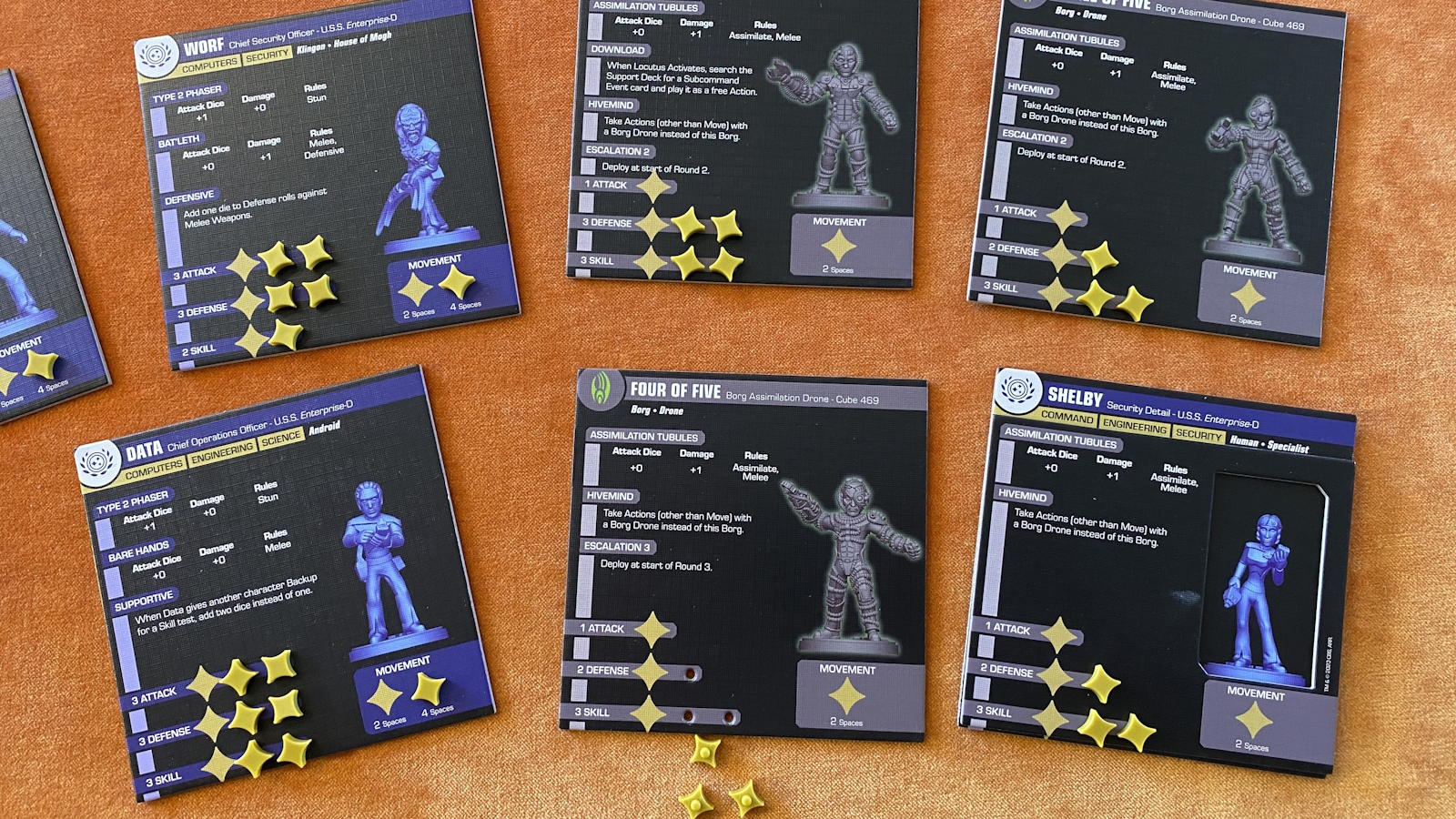
The skill tokens are a cool idea, but they have trouble staying in.
Theme
The theme of this game is spot on. I’m not a huge Star Trek fan, but I have seen the entire series of The Next Generation. All of the art being stills from the show makes you feel connected. There are a few pages of introduction story in the rulebook to give you a thematic setting for the gameplay. All of the factions and characters are also very thematic. The Federation uses stunners and diplomacy. The Borg are slow moving units that can use the hive mind to give each other actions while attempting to assimilate the opposing team. If all you care about is the theme, this game will give you exactly what you are looking for.
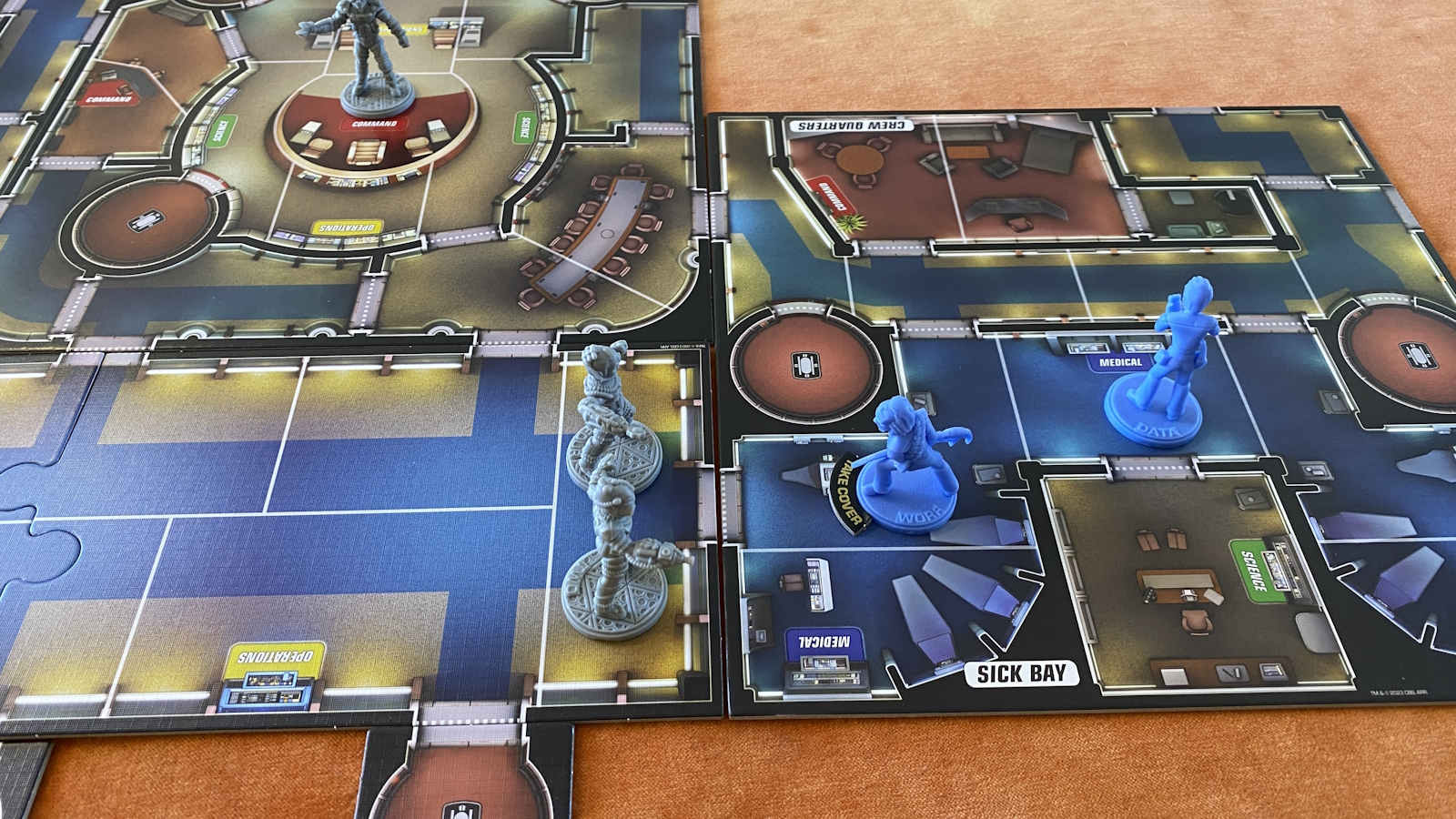
The Federation attempts to withstand the Borg onslaught.
Gameplay
Mechanically, Star Trek: Away Missions has a lot of flaws. Before the game each player gets to customize their two decks of cards, missions and support. Each faction generally has two different ways they can play, either trying to take skill tests at specific computer consoles around the ship or attempting to eliminate the opposing team. This initially seems really cool, but if both teams are just trying to interact with the game and not their opponent, then the game just ends up being really dull. If both teams just want to fight each other, then there is certainly more action, but it leads to the next problem.
The core skill test mechanic used in the game is like Risk, but worse. If you are doing a non-interactive skill test, such as trying to use a computer console, you just roll a number of dice equal to the character’s skill statistic and need at least one die to show a four or higher. In an attack skill test, both players will roll dice based on their attack or defense statistics, modified by any weapons or other equipment used. Each set of dice is arranged high to low and then paired off. For each pair of dice in which the attacker’s die is higher, it is counted as a success. Any unpaired attack die is a success on a four or higher.
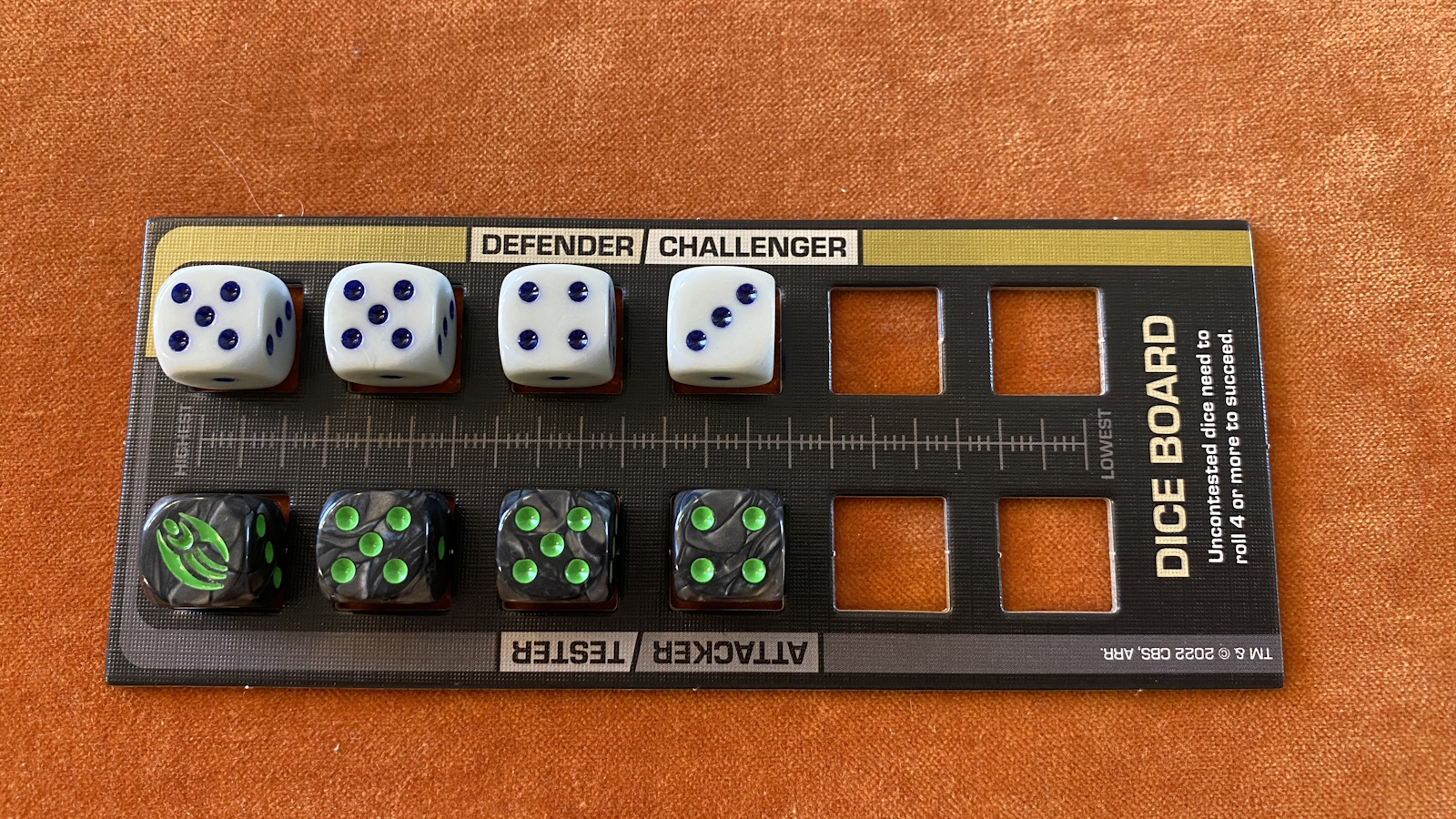
If the defender’s 3 was instead a 6, all would be well. Instead, they are going to die.
This skill test system has some huge issues. Because of the pairing system, a single die going from a one to a six can potentially be the difference between the character dying in a single attack or blocking all of the damage. Also, there are times when rolling a bunch of bad numbers is worse than not rolling at all. An uncontested die will be a success on a four or higher, but a contested three or two will also be a success if the defender’s die is a two or one. This is all somewhat mitigated by the fact that players can freely discard cards in order to reroll any number of dice. Yet, this feels like a bandaid that still doesn’t fix the underlying problems.
There are some other mechanics that don’t feel good as well. Two friendly characters together will give each other an additional die in every skill test. This makes the players always want to keep their characters in pairs. Some factions want to spread out more, and this will put them at a big disadvantage. When attacking, only the attacker will ever do damage. Doing damage degrades the statistics of the defender, making them weaker. This means attacking first is a huge advantage, but initiative each round is completely random. Or, if you’re not in position to attack yet, that means you have to spend an action moving first. Since players alternate activating characters, that initiator is now alone, meaning one less die to attack and defend against the return fire that is about to occur. If you’re the weaker of the two, you can have characters use an action to take cover. This will give you an extra defense die, which as explained above might actually be detrimental, and the action it costs is precious when most characters will take only six actions throughout the entirety of the game.
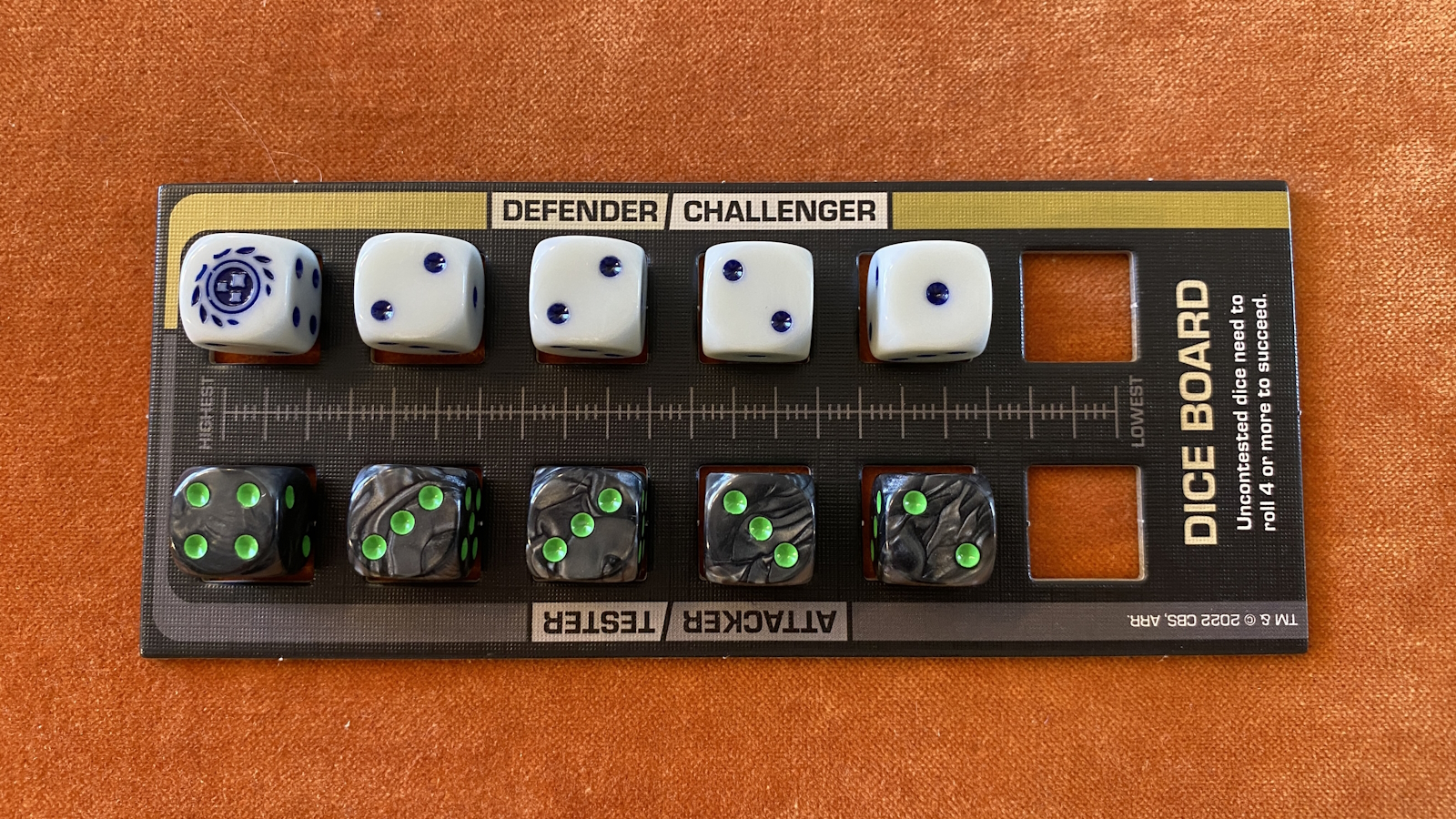
The defender only made things worse.
Expansions
Star Trek: Away Missions clearly had expansions in mind when it was designed. The rulebook even has advertisements for the first available expansions. I’m not against expandable games, and in a competitive skirmish game like this it makes a lot of sense as a good way to add variety. But, the way that they are implemented is annoying.

The first two expansions, each adding a new faction.
You can buy an expansion box for a new faction that includes everything you need to play. Currently there are two available, the Klingons and the Romulans. Inside the box are the miniatures, cards, character boards, and tokens you need. However, the storage tray only has space for the miniatures and cards. You have to store all of the cardboard components in the main box, which doesn’t have room for them either. Alternatively you can keep them in the negative space of the storage tray, but that is incredibly annoying.
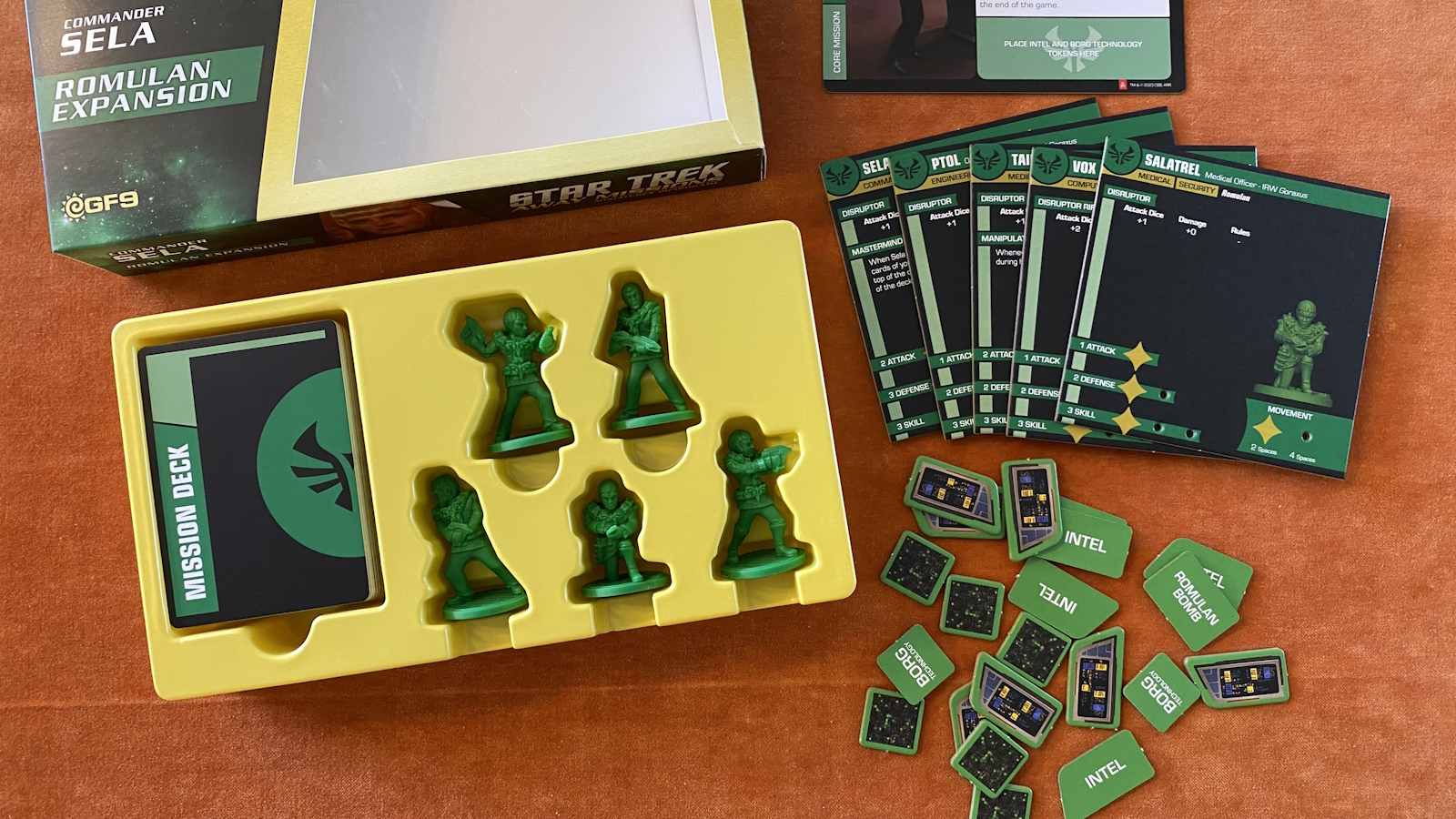
A lot of tokens and nowhere for them to go.
Even more annoying, the expansion boxes don’t come with matching faction dice. You have to buy those separately. That could be fine if you don’t really care about faction specific dice, except the core game only comes with dice that are themed for the Federation or Borg, so you are highly influenced into spending more on the dice. This feels extremely greedy to me. The dice should have been included in the main expansion box. But of course there is no storage location in the expansion box for them either. You can throw them in with the base game dice, but if you ever buy more expansions in the future there won’t be any room for those dice.

Expansion dice are sold separately.
Balance
From our play sessions, the factions do not feel very balanced. The Borg characters are all very weak and you only start with two of them. If the other player just rushes your characters early they can easily kill them off and then pick off the new ones that come in. Their abilities seem difficult to use well if your opponent knows what they’re doing. The Klingons and Romulans felt more balanced. However, the Federation feels incredibly strong. Their characters all have a lot of health, high skill values, and strong weapons. Perhaps after many plays more balance can be found, but initially it is very off putting.
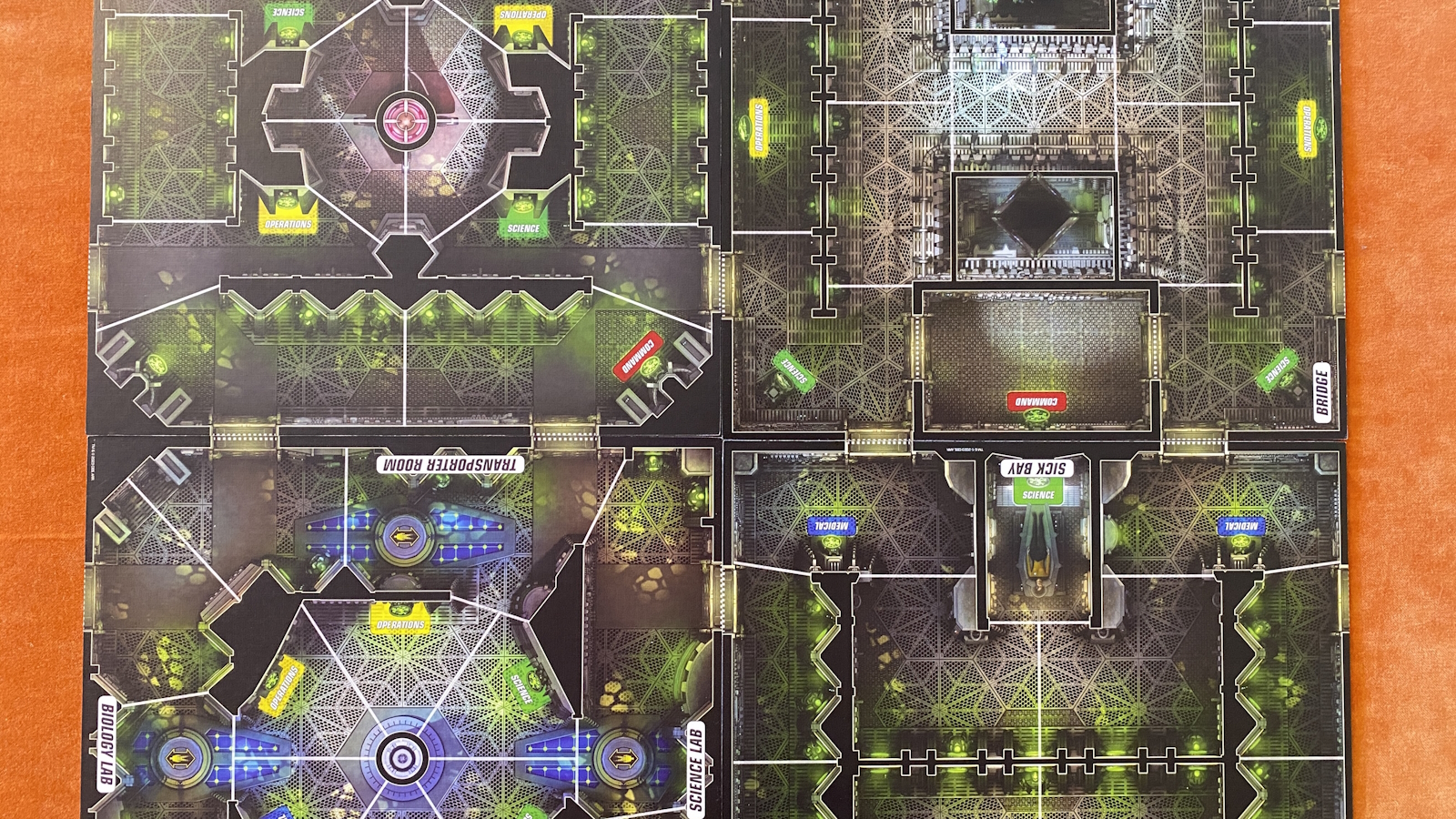
The Borg cube is somewhat difficult to read.
Conclusion
While incredibly thematic, Star Trek: Away Missions is a mediocre game. It feels like a licensed cash grab, especially with the expansion model. If you are a big Star Trek: The Next Generation fan and just want a beer and pretzels game with dice chucking randomness and minimal tactics for two, then I can recommend this game to you. But if you are looking for solid mechanics with good, long lasting gameplay, then there are better options out there.
Star Trek: Away Missions
All Right
Great theme with terrible gameplay and greedy sales model. Only recommended for Star Trek: The Next Generation super fans.
Pros
- Incredibly thematic
- Decent component quality
Cons
- Weak game mechanics
- Some bad component designs